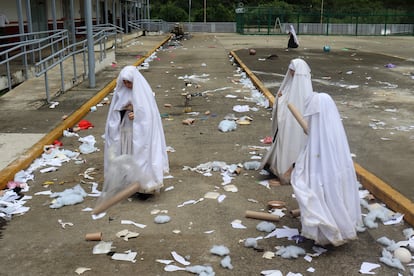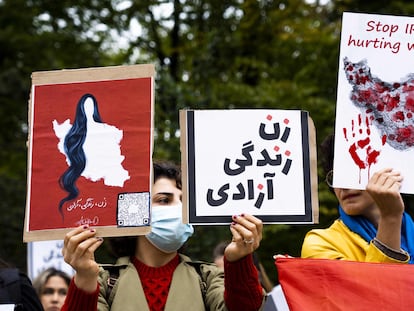Mexico delivers latest blow against Lev Tahor, the ‘Jewish Taliban’
Almost 30 members of the sect were arrested and two accused of human trafficking and child abuse after an operation to rescue a three-year-old boy

The ultra-Orthodox religious group Lev Tahor is once again in the eye of the storm after a raid by Mexican authorities resulted in the arrest of 26 members of the sect and two followers who stand accused of people trafficking and sexual abuse. The operation was carried out with the cooperation of the Israeli government to rescue a group of people who had been illegally taken to Mexico and were being held in a Lev Tahor camp in the jungle in the state of Chiapas. The Mexican press has dubbed the extremist religious sect, which has an estimated membership of between 200 and 500 people, the “Jewish Taliban” due to their beliefs and practices.
The raid was carried out by Mexican and Israeli operatives last Friday but was not made public until this week, via diplomatic sources with knowledge of the case. The operation was staged at around 5am under a heavy security deployment 17 kilometers (10 miles) from the city of Tapachula on the Guatemala border after a federal judge issued arrest warrants for several members of the sect. Over the course of the weekend other Lev Tahor adherents staged a protest outside an immigration center in Huixtla, during which they claimed to be victims of “religious persecution and of being forced to abandon their camp at gunpoint. The two members accused of trafficking and sexual abuse are being held in a Chiapas prison while the other 26 detainees are awaiting clarification of their immigration status.
According to the BBC and other sources consulted by this newspaper, one of the children rescued during the raid is the son of Israel Amir, a young man who fled the sect and approached the Israeli authorities after Lev Tahor prevented him from contacting his child. Amir told EL PAÍS during an interview last year that he had waged a legal battle lasting years to get his son back: he reported his disappearance in Guatemala and traveled there several times to seek custody after an Israeli court confirmed that he was the boy’s legal guardian. “I haven’t seen my son in over two years; the last time I saw him he was six months old,” Amir said. “I don’t know anything about him, only that he is alive.” Amir has received permission to travel to Israel from Mexico with his now three-year old son.
A representative of the Lev Tahor Survivors group says that cooperation between the government of the United States, Mexico and Israel to stop the abuses being allegedly carried out by the sect was set in motion three years ago. Last week’s raid had two objectives: firstly, to rescue those people who were being forced to remain in the sect and secondly, to arrest two Lev Tahor leaders whose identities are not yet known. The religious cult had set up in Mexico around six months ago after more than a hundred of its members were jailed in a Guatemalan prison near the border. “Our work is not yet done; we will go to the four corners of the earth if needs be, to free the girls, boys and adults who suffer the abuses of Lev Tahor,” the collective said in a statement.
Lev Tahor, which in Hebrew means “pure heart,” has been at the center of a string of controversies since it was founded in the 1980s. It was designated as a “dangerous cult” by the Israeli authorities and has been investigated for physical and sexual abuse against minors in Mexico, the United States and Canada, among other countries. After a long migration amid a Canadian investigation into child abuse, the sect settled in Guatemala in 2014, where following various conflicts with local populations it set up a hermetic and heavily guarded compound deep in the jungle. From its base there, Lev Tahor has taken advantage of the porous border with Mexico to move seasonally between Guatemala and Chiapas.
Last April, two of the sect’s leaders were sentenced to 12 years in prison for kidnapping and child sexual exploitation for performing forced marriages among the Lev Tahor’s youngest members. One of those jailed was Nachman Helbrans, son and successor of Shlomo Helbrans, the founder of the sect who died in 2017 in Chiapas, in circumstances that remain shrouded in mystery. The other was Mayer Rosner, Helbrans’ right-hand man and the second-in-command of Lev Tahor.
Toward the end of 2018, Nachman Helbrans planned the kidnap of his own nephews, grandchildren of Shlomo Helbrans, and pulled off an escape from the United States worthy of Hollywood, involving disguises, false identities and hideouts until they were detained at a Lev Tahor safe house in Mexico City. As they had always done in practically every country where they attracted the interest of the authorities, Lev Tahor claimed they were victims of religious persecution because of their anti-Zionist stance. The two kidnapped children, who were 12 and 14 at the time, were rescued at a motel in the State of Mexico and returned to the United States with their mother, who had also fled the sect.

“Being in Lev Tahor is even worse than the Taliban”
Even before the kidnapping, Lev Tahor had been the subject of intense media interest due to the sect’s strict fundamentalist rules and the control its leaders wield over members, which includes forcing women and girls to wear burqa-like head-to-toe black coverings from the age of three. Men wear somber long black suits. Lev Tahor’s practices are so extremist that they have been rejected by all other Jewish denominations, including even the more orthodox branches. During the trial of Helbrans and Rosner in the United States, EL PAÍS spoke to several former members who had left the sect after suffering physical and sexual abuse and being forced to marry as children, as well as being separated from their families. “I don’t like calling them the Jewish Taliban, because I think being in Lev Tahor is even worse,” Yoel Levy, a 20-year-old who was born into and grew up in the sect before managing to escape around three years ago, told EL PAÍS in a 2021 interview. “I was made to suffer every day I was in the sect.” Levy has denounced the group for inflicting systemic abuse and humiliation under the pretext of religious beliefs.
Amir says he witnessed Lev Tahor leaders having sexual encounters with minors first-hand. He also says at the age of 16 he was forced to marry a girl of the same age and pressurized to have children to swell the sect’s numbers. “They threatened to punish me if I refused to have sexual relations,” he told this newspaper.
“Lev Tahor is a sect that has prospered through the sexual abuse of minors,” says Marci Hamilton, a researcher at the University of Pennsylvania who has been studying the group for decades. After the sentencing of Helbrans and Rosner and the multiple allegations that have been made against the cult in Guatemala and Israel, Lev Tahor members have been located over the past few months in almost a dozen countries, from Moldova to Greece and North Macedonia to Kurdistan, Morocco and Turkey. A part of the diaspora has also resurfaced in Mexico, a country that has crossed paths with the so-called “Jewish Taliban” on more than one occasion.
Lev Tahor members leave detention center in Chiapas
According to reports from local media in Chiapas, around 20 members of the sect left a center in Huixtla run by the National System for Integral Family Development (DIF) late on Thursday, where they had been held since the raid last week. Among the group were children and adults, and sources close to the operation staged to detain several members of the group fear that the sect may now spirit the minors, many of whom hold US, Canadian, Israeli and Guatemalan passports, back to the jungle stronghold where Lev Tahor has been based for the past six months.
The circumstances behind the sect members leaving the DIF facility remain unclear. Local media suggested they had escaped, following reports that some of the detainees had rioted and assaulted guards during their detention. The National Institute of Migration has said that it has no jurisdiction over the matter and that it is the responsibility of the DIF. For its part, the DIF has said that it is corroborating the information and offered no further comment.
In the images and videos released by local media, children and adults are seen walking together outside the facility and in some of the footage guards at the entrance are seen to be pushed aside as the group got into waiting vehicles.
Tu suscripción se está usando en otro dispositivo
¿Quieres añadir otro usuario a tu suscripción?
Si continúas leyendo en este dispositivo, no se podrá leer en el otro.
FlechaTu suscripción se está usando en otro dispositivo y solo puedes acceder a EL PAÍS desde un dispositivo a la vez.
Si quieres compartir tu cuenta, cambia tu suscripción a la modalidad Premium, así podrás añadir otro usuario. Cada uno accederá con su propia cuenta de email, lo que os permitirá personalizar vuestra experiencia en EL PAÍS.
¿Tienes una suscripción de empresa? Accede aquí para contratar más cuentas.
En el caso de no saber quién está usando tu cuenta, te recomendamos cambiar tu contraseña aquí.
Si decides continuar compartiendo tu cuenta, este mensaje se mostrará en tu dispositivo y en el de la otra persona que está usando tu cuenta de forma indefinida, afectando a tu experiencia de lectura. Puedes consultar aquí los términos y condiciones de la suscripción digital.
More information
Últimas noticias
Cubans look to Venezuela fearfully after Trump’s incursion: ‘We could be next’
The operation in Venezuela to capture Maduro threatens to widen the cracks in the MAGA movement
Trump clarifies who is ultimately in charge in Venezuela: ‘Me’
Maduro pleads not guilty before the federal court in New York: ‘I am still the president of Venezuela’
Most viewed
- Alain Aspect, Nobel laureate in physics: ‘Einstein was so smart that he would have had to recognize quantum entanglement’
- Gilles Lipovetsky: ‘If you want to live better and fall in love, take Prozac, don’t look to philosophy’
- Alvin Hellerstein, a 92-year-old judge appointed by Bill Clinton, to preside over Maduro’s trial in New York
- Cuba confirms death of 32 of its citizens in the US attack against Venezuela
- Why oil has been at the center of Venezuela-US conflicts for decades











































